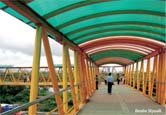The vehicle-congested areas near stations face yet more problems with the hawkers eating away into the space of walkers. This hinders the maintenance of the footpaths and also leads to pedestrians taking away the space meant for road traffic, thereby adding to the congestion on the roads. That, in return, leads to inefficient functioning of feeder buses and modal integration. To ease the situation, the planners have embarked upon an expensive, but easy way out – skywalks. The idea of a skywalk is: After alighting at a station and climbing the FOB, a commuter reaches a suitable location (without wading through road traffic, or hindering it) where other modes of transport are, or can be made, available. Though the commuter may not find the walk interesting, skywalks would be most useful to him as far as mobility is concerned. It will take time for its widespread usage as appropriate modal integration still needs to be done at the points of egress from the skywalks.
A marked difference is visible at Thane railway station, once a chaotic place. Now, buses ply at FOB levels and auto-rickshaws and taxis at road levels while skywalks lead commuters to state transport bus station. This is a good example of planned modal integration.
 Mumbai has good modal integration but its efficiency is marred by density and volume of commuters on the railway stations and consequent congestion near the stations. Newer projects like Metro Rail and Monorail, that are already underway, will be integrated with the railway system and the buses. However, if the fundamental fact of pedestrians being the largest group of public transport users is ignored and parking facilities are provided for cars and M2Ws, then the very purpose of having these projects will get defeated. This will lead to an increase in the number of cars for which providing adequate parking space will not be possible. That will again lead to road congestion.
Mumbai has good modal integration but its efficiency is marred by density and volume of commuters on the railway stations and consequent congestion near the stations. Newer projects like Metro Rail and Monorail, that are already underway, will be integrated with the railway system and the buses. However, if the fundamental fact of pedestrians being the largest group of public transport users is ignored and parking facilities are provided for cars and M2Ws, then the very purpose of having these projects will get defeated. This will lead to an increase in the number of cars for which providing adequate parking space will not be possible. That will again lead to road congestion.
Since bus stops are provided near all residential areas in Mumbai, everyone should be able to take the bus to reach the railway station, metro rail or monorail. Or, they can walk. Personal motorised transports should not be allowed near these stations. This would ease congestion problems to some extent. However, a Bus Rapid Transit System (BRTS), as an independent high capacity facility that will integrate with the system, will ease the problems of modal changes the most.
Under BRTS, buses would ply at frequencies less than a minute. The capacity of individual buses would be based on the passenger load and boarding and alighting would be just like that of Metro Rail. Feeder buses could come on to the trunk BRT lane and stop at the bus stop to enable people to alight and board at ease. That would become the point of modal interchange. Place to park bicycles could be earmarked at the concourse level, thereby providing protection to commuters on the bus stop platform below. People using other buses, auto-rickshaws, taxis and drop-offs could alight or board at roadside kerb and use the BRTS buses by climbing over the FOB and reaching the BRTS bus stop.
Providing high capacity BRTS will reduce super crush load, significantly easing the existing inefficient modal integration at railway stations. Time has come now to pay more attention to modal integration with bicycle and walking.
 Sudhir Badami
Civil Engineer and
Transportation Analyst
Sudhir Badami
Civil Engineer and
Transportation Analyst
 TrafficInfraTech Magazine Linking People Places & Progress
TrafficInfraTech Magazine Linking People Places & Progress


